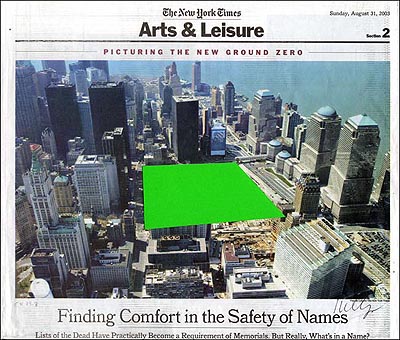previous | 11 September 2005 | next
Thoughtful NYT piece on the state of the WTC redevelopment.
This crushing failure results from an assumption that hollow symbols can be equated with democratic values. And it is compounded by a sincere, quintessentially American belief that any problem, no matter how painful or complex, can be solved through good intentions. Architecture's function here is to provide a reassuring gloss of cultural sophistication - and political cover.
I watched The Fountainhead a few nights ago, which accurately captures Rand's division of the social universe into pathological extremes. I'd love to re-make the film, using WTC reconstruction as the setting, as a critique of Rand's 'philosophy.'
Towards the end of Ouroussoff's piece:
For that reason, the most moving ideas for ground zero have always been those that treated it with the most delicacy - Norman Foster's slender undulating glass-and-steel towers, gently rising out of a sprawling park; Ellsworth Kelly's soft blanket of green, which eloquently captured the site's need for silence.

From Greg.org:
The reconstructed text of a letter from Ellsworth Kelly to the Times' architecture critic, Herbert Muschamp:
"On October 19, 2001, I wrote a letter to you (that I never sent) in response to an article in The New York Times which discussed the controversy of what was to be planned for the `Ground Zero' space, asking artists and others for their opinions. (Two artists, Joel Shapiro and John Baldessari urged that no building be erected at the site, and the architect Tadao Ando made a similar proposition.)
"At that time, my idea for the World Trade Center site was a large green mound of grass. (When I saw the aerial photograph of the site on the cover of the Aug. 31 Arts & Leisure section of the Times, [which accompanied art critic Michael Kimmelman's article, not Muschamp's. Go figure. -greg.org]) I was excited to see the site from this vantage point. I was inspired to make a collage of my idea for the space, which I am sending you.
"I feel strongly that what is needed is a 'visual experience,' not additional buildings, a museum, a list of names or proposals for a freedom monument. (These are) distractions from a spiritual vision for the site: a vision for the future."
|
